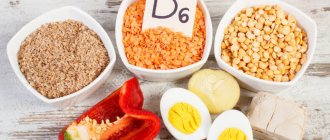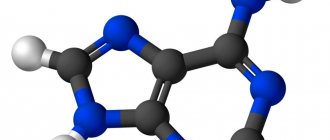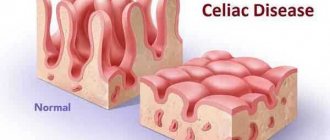Since the discovery of this organic compound, vitamin B2 has been called an important source of vitality and energy.
This vitamin is an important part of general metabolism and energy metabolism. In addition, this compound is involved in additional life support reactions of the human body. Without a regular intake of vitamin B2 into the internal environment, it is impossible to achieve good health. Despite the fact that a small amount of this vitamin can be synthesized in the lumen of the large intestine, this volume is not enough to meet the body’s needs. That is why it is recommended to constantly replenish the daily requirement for this vitamin from the outside. And if you don’t know where to buy vitamin C, which is also necessary for the body, go to our online pharmacy.
Historical information
For the first time, the picture of vitamin B2 deficiency, accompanied by other types of vitamin deficiency, was obtained in animals by N.I.
Lunin in 1880. It was discovered that mice cannot live and grow on a synthetic diet of a mixture of proteins, fats, carbohydrates and mineral salts, but develop and live well when receiving whole milk. This gave reason to believe that milk contains substances necessary for life in small quantities, which were later called vitamins (1912). Vitamin B2 was first established as a nutritional factor, the deficiency of which causes growth retardation in animals. It was finally isolated (separated) from other B vitamins in 1935, in animal experiments showing that lactosflavin did not cure canine pellagra or rat pellagra. By attempting to isolate vitamin B2 from eggs, Kuhn et al. in 1933 obtained a yellow, water-soluble, fluorescent pigment that had the property of supporting growth in animals. It was later found that flavins obtained from various sources are identical to each other and are growth-supporting vitamin B2. The structure of riboflavin was finally established in 1935, when Kagger and Kuhn independently synthesized this vitamin.
Chemical and physical properties of vitamin B2
The elucidation of the structure of vitamin B2 was helped by the observation that all drugs actively acting on growth had a yellow color and yellow-green florescence. It turned out that there is a parallelism between the intensity of this color and the growth-stimulating factor under certain conditions.
A substance with yellow-green fluorescence, soluble in water, turned out to be very common in nature; it belongs to a group of natural pigments known as flavins. These include, for example, milk flavin (lactoflavin). Lactoflavin was isolated in chemically pure form and its identity with vitamin B2 was proven. Vitamin B2 is a yellow crystalline substance, highly soluble in water, which is destroyed when irradiated with ultraviolet rays to form biologically inactive compounds (lumiflavin in an alkaline environment and lumichrome in a neutral or acidic environment).
Vitamin B2 is a methylated derivative of isoalloxazine, to which ribitol alcohol is attached at position 9; Therefore, vitamin B2 is often called riboflavin, that is, flavin to which the pentahydric alcohol ribitol is attached.
The molecular weight of riboflavin is 376.4. The melting point is 271 and 293 degrees, which apparently depends on the polymorphism of riboflavin. Two different forms of riboflavin were discovered by Shimizu in 1956 and some other researchers. These forms differed in some physical and chemical properties. Compounds with a lower melting point are more soluble in water compared to a compound with a higher melting point. The absorption spectrum, Rf value, fluorescence pattern, photolysis and chemical reactions of solutions for both forms of riboflavin are more or less identical. At room temperature it gives saturated solutions already at a content of 25 µg%. Riboflavin is less soluble in ether, chloroform and benzene. When precipitated, it forms needle-shaped orange-yellow crystals. In a neutral aqueous solution it has a bright yellow-green fluorescence with a maximum at about 545 nm. Fluorescence is associated with the presence of a free amino group in the 3rd position. Riboflavin is rapidly destroyed in alkaline solutions, especially when heated, but is highly stable in acidic environments. It is also resistant to oxidizing agents, with the exception of potassium permanganate and chromic acid. Riboflavin is very sensitive to light - up to 60% can be destroyed in 3 hours. When illuminated in an alkaline environment, its molecule loses 4 carbon atoms from the side chain and turns into lumiflamin (6,7,9 - trimethyl - isoamoxazine). When Riboflavin is illuminated in a neutral or acidic environment, it turns into lumichrome (6,7-dimethyl - aloxazil) .
Conditions required for the biological activity of riboflavin analogues
- The isoalloxine ring with the pentose residue at position 9 should remain unchanged.
- The imino group in the 3rd position should not be replaced.
- The methyl groups at the 6th and 7th positions should not be removed simultaneously.
Physico-chemical characteristics
Vitamin B2 (riboflavin) is a water-soluble organic element. It is yellow-orange crystals with a bitter taste.
The substance has a structure that is resistant to various acids and not resistant to alkalis. It is destroyed under the influence of ultraviolet rays.
Riboflavin derivatives are part of a large number of redox enzymes.
Vitamin B2, like other water-soluble complexes, does not have the ability to accumulate in living tissues. In a short period of time, it is almost completely eliminated from the body naturally.
Structure of riboflavin and its photolysis products
The presence of active double bonds in the cyclic structure of riboflavin determines some of the chemical reactions underlying its biological action. By adding hydrogen at the site of double bonds, colored riboflavin easily turns into a colorless leuco compound. The latter, giving up hydrogen under appropriate conditions, again turns into riboflavin, acquiring color. Thus, the chemical features of the structure of vitamin B2 and the properties determined by this structure predetermine the possibility of vitamin B2 participating in redox processes.
In redox reactions, semiquinone forms of riboflavin also arise, in the form of which riboflavin functions as an electron carrier. The study of riboflavin has led to the synthesis of more than 100 analogues. But among all the compounds obtained, few biologically active forms were found.
Riboflavin antagonists
Riboflavin antagonists for rats were:
- isoriboflavin (5,6 dimethylriboflavin)
- Diethylriboflavin (6.7 diethyl-9 isoaloxazine)
- galactoflavin
Of these, galactoflavin is especially often used to quickly produce severe riboflavin deficiency not only in animals, but also in humans.
All other analogues are antagonists of riboflavin for microorganisms. Antagonists of riboflavin are also antimalarial drugs, for example, acriquine and acridine dye - rivanol. Some phenazine analogues of riboflavin also serve as riboflavin antagonists in microorganisms and animals.
With regard to riboflavin analogues, it is noted that in small doses they can replace riboflavin for some time, supporting the growth of animals deprived of riboflavin, but the death of animals is accelerated. It is assumed that antagonists used in small doses displace riboflavin from its compounds and increase its content in the blood, which can contribute to a temporary improvement in the condition of animals. However, riboflavin reserves are consumed faster and death occurs earlier than in animals deprived of riboflavin and not receiving antagonists.
Effect of B2 on some organ systems
Nervous system
It was found that vitamin B2 reduces the excitability of higher nerve centers, regardless of the indicators obtained before taking the vitamin. A single dose of vitamin B2 at a dose of 10 mg causes an unstable decrease in excitability. With systematic administration of the drug, a long-term and significant decrease in the excitability of the central nervous system is observed. When the administration of riboflavin is stopped, the state of nervous excitability returns to its original state. With riboflavin deficiency, the experiment revealed functional and morphological changes in the central nervous system, as well as in the autonomic nervous system. These experimental data and clinical observations confirm the importance of B2 for the normal functioning of the central nervous system.
At the same time, long-term administration of riboflavin in doses exceeding the physiological need of the body can have an adverse effect on the nervous system.
Blood-forming organs
The experiment showed that dogs develop hypochromic anemia in the absence of riboflavin in food. After the administration of riboflavin, the hemoglobin content in the blood and the number of red blood cells increased. It was found that the administration of riboflavin led to a more rapid restoration of the number of red blood cells in guinea pigs and white rats under experimental anemia than in animals not receiving this vitamin. A faster recovery of hemoglobin under the influence of B2 was observed in white rats. This difference is thought to be caused by the different diets of guinea pigs and white rats.
Digestive organs
Vitamin B2 helps restore the content of free hydrochloric acid in gastric juice when its content is initially low. Phosphorylated riboflavin is found in significant quantities in the liver and enters the duodenum and intestines along with bile. Available observations suggest that riboflavin improves the bile excretory capacity of the liver.
Organs of vision
Riboflavin is found in the retina and is believed to play a role in the light-sensitive response of the eye. Riboflavin is involved in the metabolism occurring in the cornea, and possibly the lens. An improvement in dark adaptation has been observed after the use of riboflavin along with vitamin A in individuals with reduced dark adaptation.
Absorption and metabolism of riboflavin in the body
Riboflavin is better absorbed in the presence of hydrochloric acid in the gastric juice, but it is absorbed in the small intestine. Riboflavin absorbed in the intestine undergoes phosphorylation. Absorption of riboflavin, chemically bound to protein, occurs after it is released from the protein during phosphorylation. In this case, 2 coenzyme forms of the vitamin are formed - flavin mononucleotide (FMN) and flavin adenine dicinucliotide (FAD). Phosphorylation of B2 can occur in the intestinal mucosa, as well as in liver, blood and other cells of the body. In studies with the administration of labeled riboflavin, the appearance of labeled FMN and FAD was noted in the small intestine, liver and kidneys. Phosphorylation is catalyzed by flavokinase, which has been isolated from yeast, plants and rat liver.
Riboflavin + ATP ———flavokinase———FMN + ADP
FMN + ATP————pyrophosphorylase———FAD + pyrophosphate
This process occurs with the participation of ATP. FMH is the active group of some flavin enzymes. However, most flavin enzymes contain FAD as an active group, in which the phosphorus ester of riboflavin is linked to adenylic acid. With insufficient B2 intake in animals, along with growth retardation, there is a decrease in its excretion in the urine, although the content in the blood and organs does not yet change. With ariboflavinosis, the excretion of riboflavin in the urine approaches 0. Death of animals from ariboflavinosis occurs, however, when 1/2 - 1/3 of the normal riboflavin content remains in the organs. In the blood, riboflavin remains longer, especially in leukocytes. It is noted that there is a ceiling for the content of riboflavin in organs, after which an increase in the dietary vitamin does not cause an increase in its content in tissues. The issue of end products of B2 metabolism has not been sufficiently studied. It has been shown that up to 98% of the radioactivity of riboflavin remains in the carcass, urine and feces of the rat, and only a very small amount is released as radioactive CO2. Small amounts of lumiflavine and lumichrome are found in feces. It is obvious that these products of riboflavin metabolism appear in feces as a result of the activity of intestinal flora and, under physiological conditions, the ribitol side chain of riboflavin is not destroyed in the tissues of rats.
Use in sports nutrition
Riboflavin is a valuable component for those whose activities involve increased physical activity. This is because vitamin B2:
- Participates in protein synthesis.
- Stimulates intercellular oxygen exchange, preventing the development of hypoxia.
- Improves muscle activity during sports.
- Promotes recovery after workouts.
With the systematic use of dietary supplements with vitamin B2, endurance increases and athletic performance improves.
Requirement for vitamin B2
An adult's need for vitamin B2 is from 2.5 to 3.5 mg per day and from 1 to 3 mg for children. For the most part, this need is satisfied through food. Systematic consumption of B2 is especially important for women during pregnancy and lactation, children and adolescents, and people performing heavy physical work. There is evidence that with irregular consumption of vitamin B2, the need for it increases, so vitamin B2 must be administered with food daily. Intestinal bacteria synthesize B2, but it has not been established how much synthesized riboflavin can be absorbed in the human colon. When calculating dietary vitamin B2, you need to take into account only its content in food and in medications, if they were used.
Vitamin B2 content in food products
Vitamin B2 is widely distributed in all animal and plant tissues. It occurs either in a free state (eg, milk, retina) or, in most cases, as a protein-bound compound. Particularly rich sources of vitamin B2 are yeast, liver, kidneys, mammalian heart muscle, and fish products. Many plant foods are quite high in riboflavin.
The danger of hypervitaminosis
The occurrence of clinical manifestations of riboflavin hypervitaminosis exists if a person daily consumes excessive amounts of this organic compound with pharmaceutical vitamin preparations or nutritional supplements.
With an excessive intake of this vitamin into the internal environment, a person experiences such manifestations of hypervitaminosis as dizziness, general weakness, numbness of the lower and upper extremities, as well as a sensation of itching and burning in the upper and lower extremities. With excessive consumption of vitamin B2, a person runs the risk of cerebral insufficiency or fatty liver hepatosis. Having purchased vitamin C inexpensively, we also recommend following the daily intake.
B2-vitaminosis
In rats, mice and chickens on a diet deprived of vitamin B2, growth stops after 2-3 weeks. This symptom is an important and reliable indicator of vitamin B2 deficiency. Although growth retardation is characteristic to one degree or another for a lack of each of the vitamins, the effect on growth of vitamin B2, as well as vitamin A, is most pronounced. Rats placed on a diet without vitamin B2 develop nonspecific dermatitis, which manifests itself in changes in structure (loss of shine, fading) and hair loss, the formation of scales on the skin, and a decrease in the ability of animals to reproduce. At the same time, the rats stop gaining weight. In dogs, vitamin B2 deficiency causes bradycardia, cardiac arrhythmia, yellow coloration of the liver, and pathological changes in the central nervous system. Dogs experience paresis of the upper limbs, adynamia, a staggering gait, collapse, deep coma and death. With early administration of large doses of B2, it was possible to bring animals out of a comatose state.
B2 - vitamin deficiency in humans manifests itself in the form of an inflammatory process of the oral mucosa, starting in the corners of the mouth and spreading to the skin. The mucous membrane of the lips turns pale and begins to get wet. The epithelium is mocerated and then desquamated. Cracks form and become crusty. After the crust falls off, an ulcer (jam) forms. Cracks can cover the entire surface of the lips (cheilosis, stomatitis). Seborrheic dermatitis develops on the nasolabial fold, wings of the nose, eyelids and ears. Dermatitis can develop on the scalp, scrotum and other parts of the body.
Holosites develop in the same way. The tongue initially takes on a granular appearance due to the enlargement of the fungiform papillae. Teeth marks are visible along the edges of the tongue. As a result of atrophy of the papillae, the surface of the tongue becomes bright red and smooth. Patients complain of a burning sensation of the tongue and increased salivation. Weight loss, weakness, loss of appetite, headache, decreased performance and especially the ability to do mental work are noted. There is rapid visual fatigue, photophobia, lacrimation, and a burning sensation. As a result, creanitis develops, increased vascularization and opacification of the cornea are noted, conjunctivitis and retrobulbar neuritis often develop. Patients often experience nervous disorders, manifested in muscle weakness, burning pain in the legs, ataxia, hyperkinesis, and nystagmus. The healing of wounds is delayed, trophic ulcers are observed. Relatively rarely, ariboflavinosis occurs as an independent disease. More often it manifests itself along with other symptoms - metabolic disorders due to qualitatively insufficient nutrition and is accompanied by signs of deficiency of other B vitamins.
IN 1
Lack of B1 leads to energy deficiency, since the process of metabolism (metabolism) of carbohydrates is disrupted. As a result, the synthesis of fat-soluble acids, some hormones and amino acids is disrupted. One of the most well-known problems caused by chronic B1 deficiency is beriberi disease, which is common in countries where refined rice is the staple food. A large risk group is people with diabetes, since thiamine deficiency can lead to complications such as the development of polyneuropathy. Polyneuropathy is one of the most severe neurological disorders, which is characterized by multiple lesions of peripheral nerves. In diabetes, an excess amount of glucose causes metabolic disorders with damage to nerves and blood vessels, including those supplying the nerves. The main symptoms of polyneuropathy are loss of sensation in the lower extremities (arms, feet), burning sensation and crawling sensations, instability when walking3.
Medicinal use
For diseases of the digestive system
The use of vitamin B2 is of greatest importance for liver diseases, primarily for Botkin’s disease. In patients with Botkin's disease, with a normal diet, the excretion of vitamin B2 in the urine sharply decreases and increases very slightly after loading with this vitamin. There was a relationship between the excretion of vitamin B2 in the urine and the severity of the disease. In severe cases of the disease, the excretion of B2 in the urine sharply decreases. During recovery, the release of riboflavin increases. Therefore, urinary excretion of riboflavin can be used to some extent in clinical practice as an indicator of the severity of the disease and the state of liver function. Disturbances in B2 metabolism have been established in cirrhosis of the liver and in changes in the liver that occur during circulatory failure. This leads to disruption of the liver’s ability to accumulate riboflavin and the development of hyporiboflavinosis, which is quite often observed in liver diseases. Therefore, the use of vitamin B2 in this case is justified and indicated. With vitamin B2 deficiency, a violation of the endocrine activity of the pancreas was revealed, which was manifested in a decrease in the amount of insulin in the blood. The administration of riboflavin increases insulin levels, which is one of the ways to influence impaired carbohydrate metabolism. Also, in case of Botkin's disease, clinical and laboratory parameters improve (normalization of the Quick test and bilirubin level in the blood, disappearance of urobilinuria, etc.) after treatment with riboflavin preparations.
For heart diseases
For heart diseases accompanied by myocardial malnutrition (myocardial dystrophy), the use of vitamin B2 helps normalize metabolism in the heart muscle.
For infectious diseases
The use of riboflavin is indicated along with other vitamins for infectious diseases accompanied by fever (pneumonia, septic endocarditis, etc.), since due to increased metabolic processes, the consumption of riboflavin increases.
For skin diseases
Vitamin B2 has received quite wide use in the clinic of skin diseases. It is recommended in combination with other measures in the treatment of erythroderma, exfoliative dermatitis, seborrheic eczema, streptococcal skin lesions, photodermatoses, burns, leg ulcers and some other skin diseases.
Beneficial features
Riboflavin has beneficial effects on health. As a result of taking drugs based on it, the following is noted:
- improvement of general well-being;
- increasing energy potential;
- reduction of irritability and anxiety;
- slowing down age-related changes in the brain;
- improved muscle function, including the heart;
- relief from headaches, migraines;
- optimization of visual functions;
- normalization of blood clotting;
- rapid healing of damaged tissues;
- improvement of the condition of skin, hair, nails;
- increasing the body's resistance.
Doctors recommend that women take vitamin B2 during pregnancy, as this component promotes the proper development of the fetus.
Therapeutic doses and preparations of vitamin B2
The following dosages of vitamin B2 (orally) are used: for adults a single dose of 5-10 mg, daily up to 50 mg, for children a single dose of 2-10 mg, daily up to 20 mg, depending on the age of the child.
Vitamin B2 is available in the form of powder, tablets and dragees. In powder form, it is yellow-orange in color. The dragee has a creamy color, sweet taste with a hint of vitamin. The weight of the dragee is 0.25 g and contains 2 mg of vitamin B2. The drug riboflavin mononucleotide, which is a product of phosphorylation of this vitamin, is currently being produced. It is a ready-made form of coenzyme produced in the body from riboflavin. Riboflavin mononucleotide is used parenterally and is contained in ampoules in the form of a 1% solution containing 10 mg of vitamin per ml. Riboflavin mononucleotide is administered for skin and other diseases, 1 ml of a 1% solution once a day for 10-15 days. For children, the drug is administered in the same dose for 3-5 days in a row, and then 2-3 times a week. The total course is 15-20 injections. For eye diseases, 0.2 - 0.5 ml of a 1% solution is administered intramuscularly for 10-15 days and at the same time 0.1-0.5 ml of a 1% solution is administered under the conjunctiva for 8-15 days. Store the drug in a place protected from light.
Author of the article: Associate Professor of the Department of Biochemistry, MBF RSMU, Ph.D. Adrianov Nikolay Vladimirovich. Especially for Electronic Medicine LLC.
Best Vitamin B2 Supplements
Almost all major brands offer vitamin B2 supplements. However, assessing the quality and effectiveness of a supplement depends on many criteria: serving size, form of active ingredient, number of servings per package and average cost of each tablet. Among the most popular brands, which are in great demand, are distinguished by high quality and benefits, there are:
- Vitamin B2 from Solgar is a supplement from a well-known and reputable brand. It has high quality and bioavailability. The standard package includes 50 mg of riboflavin per tablet;
- Solgar Vitamin B2 (100 mg) is another supplement from Solgar that offers the best value for money. A serving contains twice as much riboflavin, although the price per package of 100 capsules is only 15-20% higher than the tablet form;
- Nature's Way B-100 Complex is the best option for those who need the full spectrum of B vitamins with additional substances that promote absorption. Includes ultra-high dosages, the use of which is not dangerous (the body effectively removes all excess). It is used in cases where it is necessary to quickly prevent a deficiency and ensure that the body’s needs are met even in the case of poor absorption in the intestines.









